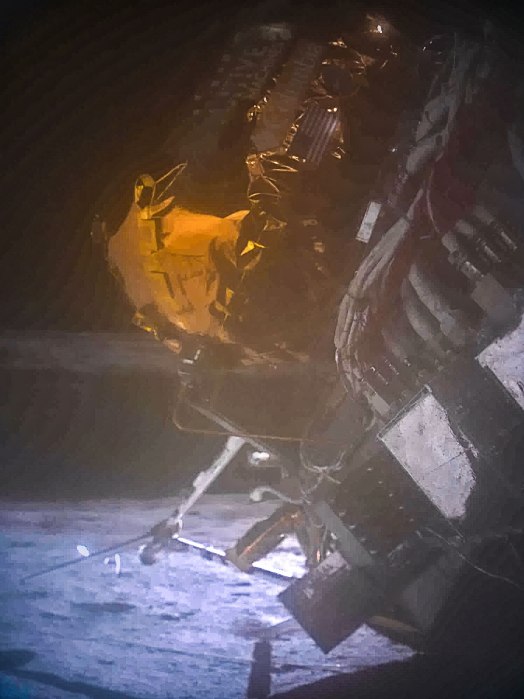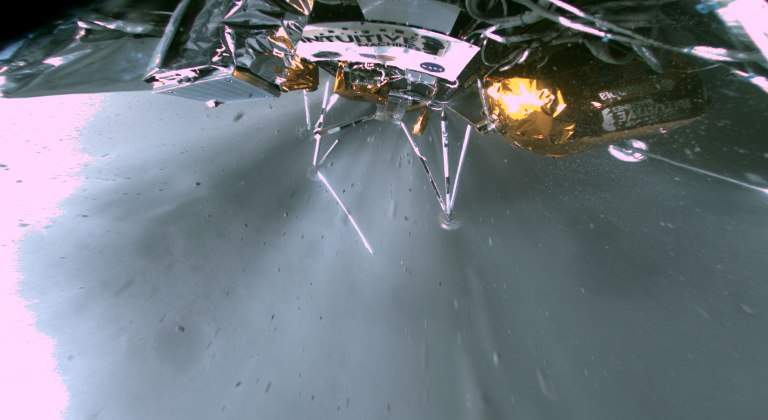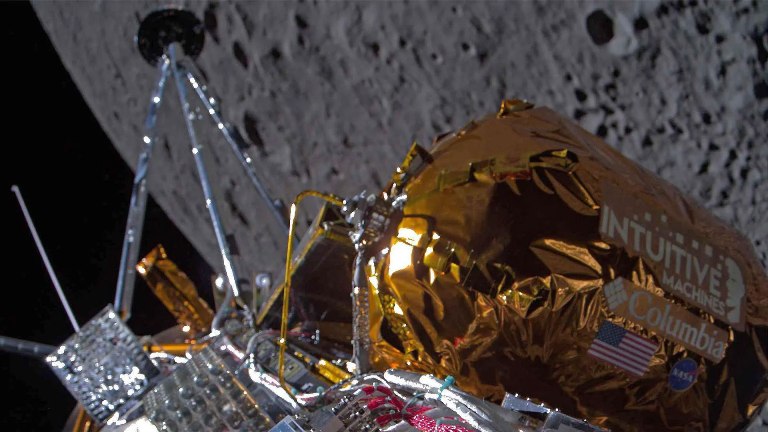After launching on February 15, Intuitive Machines’ Odysseus lander touched down in the moon’s south polar region on February 22 and has since transmitted valuable science data back to Earth. Odysseus took six NASA payloads with him, and their data is essential for future human exploration of the Moon under Artemis. This is the first commercial unmanned mission to the Moon. For the first time in more than 50 years, NASA was able to collect data using new scientific instruments and technology demonstrations on the Moon. The data comes from the first successful payload landing of NASA’s CLPS (Commercial Lunar Payload Services) initiative and Artemis campaign.
Intuitive Machines’ Nova-C lander, called Odyssey, completed a seven-day journey into lunar orbit and completed soft landing procedures near Malapert A near the Moon’s South Pole at 5:24 pm ET on February 22. NASA’s Artemis Campaign is delivering to the moon in a region where NASA will send astronauts to search for water and other lunar resources later this decade.

The Odyssey’s landing shot captured its “leg” as it performed its primary task of making first contact with the lunar surface. The lander’s liquid methane and liquid oxygen engine was still running, ensuring a stable landing.
“For the first time in more than half a century, America has returned to the moon. Congratulations to Intuitive Machines for sending the Odyssey lunar lander carrying NASA science instruments to a place where no machine or man has gone before—the South Pole of the Moon,” said NASA Administrator Bill Nelson. “This feat by Intuitive Machines, SpaceX and NASA demonstrates the promise of American leadership in space and the power of commercial partnerships through NASA’s CLPS initiative. In addition, this success opens the door to new Artemis-led voyages to send astronauts to the Moon and then to Mars.”
The six instruments ceased scientific and technical activities seven days after landing at the lunar South Pole aboard Intuitive Machines’ Odyssey, having completed their planned pre-launch missions. Known as IM-1, it was the first U.S. soft landing on the Moon in decades, proving that commercial suppliers can deliver instruments designed to advance scientific and technological knowledge on the Moon.
On board the lunar lander, NASA’s scientific instruments measured the radio noise generated by the Earth and the Sun. Also on board were other technological instruments that helped the intuitive machines navigate to the Moon and determine the distance and speed of the lander when landing on the lunar surface.

February 27, Odysseus took a photo using a camera with a narrow field of view
NASA’s Navigation Doppler Lidar Precise Speed and Range (NDL) guidance system for descent and landing ultimately played a key role in facilitating a successful landing. Hours before landing, Intuitive Machines encountered a sensor problem in its navigation system and turned to NASA’s guidance system to help it land accurately. NASA’s instrument operates on the same principles as radar and uses laser pulses emitted through three optical telescopes. It measures speed, direction and altitude with high accuracy during descent and landing.
NASA’s instruments focused on studying interactions with the lunar surface and radio astronomy. The Odyssey lander also features a retroreflector system that will help create a network of lunar location markers for communications and navigation for future autonomous navigation technologies.
During descent, a radio frequency mass sensor and navigation Doppler lidar collected data during the lander’s descent and landing. After landing, payload data was obtained subject to communications and other constraints imposed by the lander’s orientation. During ground operations, radio wave observation stations on the lunar surface of the photoelectron shell and lunar node-1 were turned on, performed ground operations and acquired data.

Stereo lunar plume-surface cameras were turned on and captured images during the transit and several days after landing, but they failed to successfully capture images of the interaction of the lander’s rocket plume with the lunar surface during landing. The Laser Retroreflector Array is passive and initial estimates indicate that it is available for laser applications ranging from the Lunar Reconnaissance Orbiter’s laser altimeter to the creation of a permanent location marker on the Moon.
Additional NASA equipment aboard the lander includes:
– Lunar Node Navigation Demonstrator 1: A small CubeSat-sized experiment that will demonstrate autonomous navigation that can be used by future landers, ground infrastructure, and astronauts by digitally confirming their position on the Moon relative to other spacecraft, ground stations, or rovers on the Moon. The LN-1 was designed, built and tested at NASA’s Marshall Space Flight Center.
– Laser retroreflector array: a set of eight retroreflectors that provide precise laser ranging, that is, measuring the distance between an orbiting or landing spacecraft and a reflector on the lander. The array is a passive optical instrument and will function as a permanent location marker on the Moon for decades to come.
– Radio Frequency Mass Sensor: A demonstration of technology that measures the amount of fuel in a spacecraft’s tanks in low gravity conditions. Using sensor technology, the sensor will measure the amount of cryogenic fuel in Nova-C’s propellant and oxidizer tanks, providing data that could help predict fuel consumption on future missions.
– Radio wave observations of the lunar surface photoelectron shell: The instrument will observe the surface environment of the Moon at radio frequencies to determine how natural and man-made activity near the surface interacts with and may interfere with the science being conducted there.
– Lunar Plume-Surface Stereo Cameras: A set of four tiny cameras to capture images showing how the Moon’s surface changes as a result of interaction with the spacecraft’s engine plume during and after descent.




